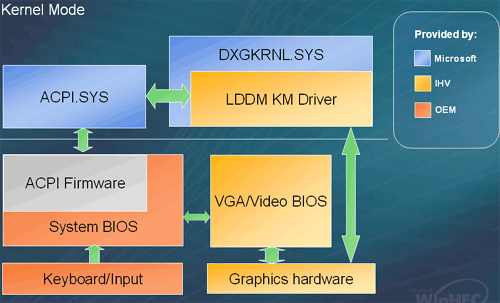WinHEC 2005 - Keynote and Day 1
by Derek Wilson & Jarred Walton on April 26, 2005 4:00 AM EST- Posted in
- Trade Shows
Thoughts on the Longhorn Driver Model
The x64 launch aside, we have heard about some very interesting hardware refinements that Microsoft wants to see happen by the time we reach Longhorn availability. As Gates mentioned in his keynote, the Longhorn driver model is finished. This means that hardware vendors can begin making sure their hardware will run smoothly under Longhorn today. It also means that we are able to catch a glimpse of what things will be like when Longhorn finally comes along.
One of the most interesting things to us is the Longhorn Display Driver Model (LDDM). Under the new display driver model, Microsoft wants to more closely integrate the graphics hardware with the operating system. In order to do this, a couple things are going to happen. First, graphics drivers will give up management of graphics memory to Windows. Windows will then handle the complete virtualization and management needs of graphics memory. This will have a large impact on the way graphics hardware vendors approach driver writing. In spite of the simplification windows memory management will bring to the graphics subsystem, different management techniques may lend themselves more readily to one hardware architecture or another. Right now, we are hearing that ATI and NVIDIA are both playing nice with Microsoft over what will happen when they lose the full control of their own RAM, but we will be sure to keep abreast of the situation.
In addition to the above issues with the LDDM (i.e. Windows sometimes has problems managing system RAM, and now they're going to manage VRAM?), Windows can't manage memory that is taken up by the video bios. There has been a push towards UEFI (Unified Extensible Firmware Interface) as a replacement to the archaic BIOS, and Microsoft would like to see the video BIOS become more entwined with the operating system. The plan right now is to make use of ACPI in order to facilitate this, but we may see even more advancements when we have UEFI hardware. Maintaining a higher level of integration on all fronts with the OS should help make more display options automatic and highly accessible.
Even if UEFI makes it into all hardware platforms by the end of 2006 and graphics hardware vendors take up the cause, we will still need to have legacy BIOS and VGA firmware support in all computers in order to run older (i.e. non-Longhorn) Operating Systems. AMD likens this transition to the current x86-64 transition. Hardware will support legacy and advanced functionality for some time until the user install base is such that legacy support can be dropped.










36 Comments
View All Comments
nastyemu25 - Tuesday, April 26, 2005 - link
uh, "readily available"Viditor - Tuesday, April 26, 2005 - link
A quick note:"and with the largest readily available DIMMs currently coming in at 2 GB in size"
I believe that Samsung, AMD and MSoft were showing 4GB Registered Dimms at the show...
http://home.businesswire.com/portal/site/google/in...
Shinei - Tuesday, April 26, 2005 - link
What makes Microsoft think they know how to use video card memory better than the hardware creators and their respective driver teams? If their memory management in Windows XP is any indication, I imagine everyone will need 1536MB video cards just to play Half-Life 1... And no, that's not a typo.AtaStrumf - Tuesday, April 26, 2005 - link
he, he, HEC = JOKE in my languageThere's your explanation Kristopher ;-)
KristopherKubicki - Tuesday, April 26, 2005 - link
Who wrote those MS slides!Page 1 "An" Historical... ????
Page 6 "Compute" Cluster Edition....
Usually its bad to get the slides wrong on Day 1 of your own event!
Kristopher
Icehawk - Tuesday, April 26, 2005 - link
I'm up too early!